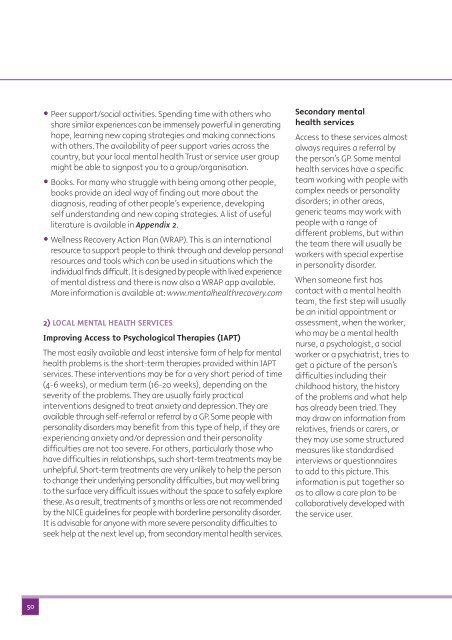Meeting-The-Challenge-Making-a-Difference-Practitioner-Guide
Meeting-The-Challenge-Making-a-Difference-Practitioner-Guide
Meeting-The-Challenge-Making-a-Difference-Practitioner-Guide
Create successful ePaper yourself
Turn your PDF publications into a flip-book with our unique Google optimized e-Paper software.
• Peer support/social activities. Spending time with others who<br />
share similar experiences can be immensely powerful in generating<br />
hope, learning new coping strategies and making connections<br />
with others. <strong>The</strong> availability of peer support varies across the<br />
country, but your local mental health Trust or service user group<br />
might be able to signpost you to a group/organisation.<br />
• Books. For many who struggle with being among other people,<br />
books provide an ideal way of finding out more about the<br />
diagnosis, reading of other people’s experience, developing<br />
self understanding and new coping strategies. A list of useful<br />
literature is available in Appendix 2.<br />
• Wellness Recovery Action Plan (WRAP). This is an international<br />
resource to support people to think through and develop personal<br />
resources and tools which can be used in situations which the<br />
individual finds difficult. It is designed by people with lived experience<br />
of mental distress and there is now also a WRAP app available.<br />
More information is available at: www.mentalhealthrecovery.com<br />
2) LOCAL MENTAL HEALTH SERVICES<br />
Improving Access to Psychological <strong>The</strong>rapies (IAPT)<br />
<strong>The</strong> most easily available and least intensive form of help for mental<br />
health problems is the short-term therapies provided within IAPT<br />
services. <strong>The</strong>se interventions may be for a very short period of time<br />
(4-6 weeks), or medium term (16-20 weeks), depending on the<br />
severity of the problems. <strong>The</strong>y are usually fairly practical<br />
interventions designed to treat anxiety and depression. <strong>The</strong>y are<br />
available through self-referral or referral by a GP. Some people with<br />
personality disorders may benefit from this type of help, if they are<br />
experiencing anxiety and/or depression and their personality<br />
difficulties are not too severe. For others, particularly those who<br />
have difficulties in relationships, such short-term treatments may be<br />
unhelpful. Short-term treatments are very unlikely to help the person<br />
to change their underlying personality difficulties, but may well bring<br />
to the surface very difficult issues without the space to safely explore<br />
these. As a result, treatments of 3 months or less are not recommended<br />
by the NICE guidelines for people with borderline personality disorder.<br />
It is advisable for anyone with more severe personality difficulties to<br />
seek help at the next level up, from secondary mental health services.<br />
Secondary mental<br />
health services<br />
Access to these services almost<br />
always requires a referral by<br />
the person’s GP. Some mental<br />
health services have a specific<br />
team working with people with<br />
complex needs or personality<br />
disorders; in other areas,<br />
generic teams may work with<br />
people with a range of<br />
different problems, but within<br />
the team there will usually be<br />
workers with special expertise<br />
in personality disorder.<br />
When someone first has<br />
contact with a mental health<br />
team, the first step will usually<br />
be an initial appointment or<br />
assessment, when the worker,<br />
who may be a mental health<br />
nurse, a psychologist, a social<br />
worker or a psychiatrist, tries to<br />
get a picture of the person’s<br />
difficulties including their<br />
childhood history, the history<br />
of the problems and what help<br />
has already been tried. <strong>The</strong>y<br />
may draw on information from<br />
relatives, friends or carers, or<br />
they may use some structured<br />
measures like standardised<br />
interviews or questionnaires<br />
to add to this picture. This<br />
information is put together so<br />
as to allow a care plan to be<br />
collaboratively developed with<br />
the service user.<br />
50


